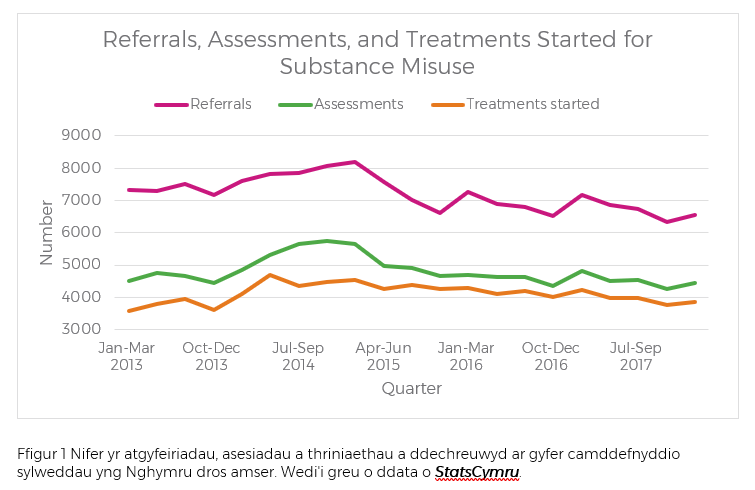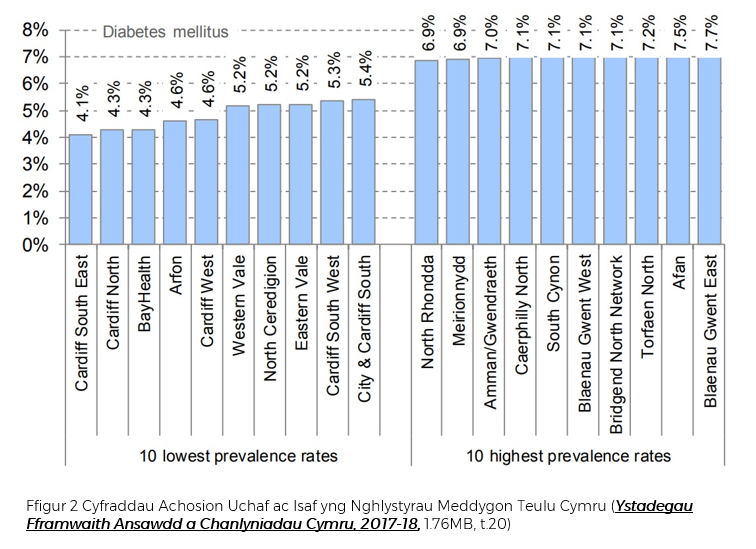Alcohol Awareness Week, launched by the charity Alcohol Concern, is an initiative with the aim of driving the conversation about alcohol, signposting support, and calling for change “at every level”.
Alcohol misuse is covered by the Welsh Government’s “Working Together to Reduce Harm (Substance Misuse) Delivery Plan 2016-18” (PDF, 753KB), which has been the focus of a previous blog post.
The Welsh Government’s 2018 annual report (PDF, 3.96MB) on the substance misuse delivery plan noted some key statistics regarding alcohol:
- In 2017, 18% of adults reported drinking over the weekly guidelines, down from 20% in 2016 (p.15).
- The number of individuals admitted to hospital for an alcohol specific condition had fallen by 8.8% over five years, with variation around this figure for different age groups (p.15).
- 52% of referrals for substance misuse assessment were for problematic alcohol use as the main substance, compared to 47% for problematic drug use (p.9).
- Males accounted for 62.6% of alcohol assessments by specialist substance misuse providers in 2017/18, and 70.3% of drug assessments (p.9).
- For alcohol misuse, 90% of cases began treatment within 20 working days of a referral – 10% over the target of 80% (p.10).
- 77.0% of people have completed treatment either problematic substance free or have reached their treatment goals in 2017/18 compared to 71.83% in 2013/14, whilst 84.9% of people reported improved quality of life following treatment compared to 92.3% over the same period (p.10).
The numbers of referrals, assessments, and treatments started for substance misuse are shown in Figure 1.  There are some stable reported (PDF, 1.71MB) differences in the age trends for alcohol- and drug-related referrals. The median age for alcohol referrals in 2016-17 was 42, compared to the median age of 32 for drugs, whilst clients under 30 years of age accounted for 16.7% of alcohol referrals and 39.5% of drug referrals. As Figure 2 shows, the greater number and tendency towards higher age of alcohol-specific hospital admissions compared to drug-related admissions was stable between 2012-13 and 2016-17, with a peak in the 50-54 year old age group for alcohol-related admissions.
There are some stable reported (PDF, 1.71MB) differences in the age trends for alcohol- and drug-related referrals. The median age for alcohol referrals in 2016-17 was 42, compared to the median age of 32 for drugs, whilst clients under 30 years of age accounted for 16.7% of alcohol referrals and 39.5% of drug referrals. As Figure 2 shows, the greater number and tendency towards higher age of alcohol-specific hospital admissions compared to drug-related admissions was stable between 2012-13 and 2016-17, with a peak in the 50-54 year old age group for alcohol-related admissions. 
Minimum Pricing for Alcohol
Carwyn Jones stated that “it is our long-held aim to use public health measures to target and tackle the harmful and hazardous consumption of alcohol. […] Legislation is an essential component of our wider strategy to reduce alcohol-related harm”.
A report (PDF, 2.45MB) commissioned by the Welsh Government and conducted by the Sheffield Alcohol Research Group at the University of Sheffield estimated that minimum unit pricing policies “would be effective in reducing alcohol consumption, alcohol related harms (including alcohol-related deaths, hospitalisations, crimes and workplace absences) and the costs associated with those harms” (pg.8). Conversely, “a ban on below-cost selling (implemented as a ban on selling alcohol for below the cost of duty plus the VAT payable on that duty) would have a negligible impact on alcohol consumption or related harms”. The most substantial effects would be experienced by higher risk drinkers and those in poverty, with only a “small impact on moderate drinkers”. The report suggested that those in poverty would also experience “larger relative gains in health and the high risk drinkers are estimated to marginally reduce their spending due to their reduced drinking under many policies”.
In June 2018 the Assembly approved The Public Health (Minimum Price for Alcohol) (Wales) Bill which aims to “address longstanding and specific health concerns around the effects of excess alcohol consumption”. The explanatory memorandum (PDF, 2.85MB) states that the Bill “provides for a minimum price for the sale and supply of alcohol in Wales by certain persons and makes it an offence for alcohol to be sold or supplied below that price”. Similar legislation was passed by the Scottish Parliament and was subject to a challenge by the Scotch Whisky Association and others on the grounds that the legislation was incompatible with EU law – though this appeal was unanimously dismissed (PDF, 136KB) by the Supreme Court.
Cabinet Secretary for Health and Social Services Vaughan Gething commented that this “legislation takes a sensible, targeted approach to a very real and evident problem in Wales today. But it will be supported by a range of additional actions being taken forward to support those in need – forming part of the Welsh Government’s wider Substance Misuse Strategy”. The Bill received Royal Assent on 9th August 2018.
In a written statement dated 28th September 2018, Vaughan Gething elaborated that “The Public Health (Minimum Price for Alcohol) (Wales) Act 2018 is targeted at protecting the health of hazardous and harmful drinkers who tend to consume greater amounts of low-cost and high-strength alcohol. It provides a formula for calculating the applicable minimum price for alcohol by multiplying the percentage strength of the alcohol, its volume and the minimum unit price. This allows us to target the sale and supply of low-cost and high-strength alcohol”.
A consultation into the preferred level for the minimum unit price was launched on 28th September and is due to run for 12 weeks. Following the implementation of minimum unit pricing at 50p in Scotland, the Scottish Liberal Democrat leader Willie Rennie called for a higher 60p minimum unit price because “inflation has eroded the value of the original minimum price”. The Welsh Government’s position is that a 50p minimum unit price “is a proportionate response to tackling the health risks of excessive alcohol consumption.”
Article by Alistair Anderson, National Assembly for Wales Research Service The Research Service acknowledges the parliamentary fellowship provided to Alistair Anderson by the Economic and Social Research Council, which enabled this Research Briefing to be completed.






